OK, I’m probably crazy to do this again after the last one, but here goes with another series of Playing Lessons.
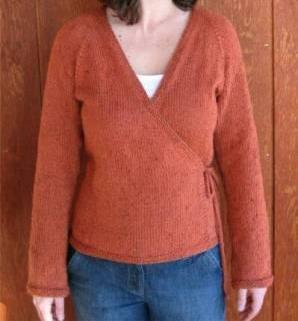 This time, though, I’ll be designing the thing myself, so any issues will be mine and mine alone. (However, this is not guaranteed to cut down on the drama factor. More than likely, the opposite.)
This time, though, I’ll be designing the thing myself, so any issues will be mine and mine alone. (However, this is not guaranteed to cut down on the drama factor. More than likely, the opposite.)
The original inspiration here is from a Knitting Pure & Simple pattern, for a basic little wrap cardigan. I’ve been thinking about doing this one for a while, but hadn’t quite gotten around to it — until the other day at the LYS when I saw Stephanie (no, not that Stephanie) wearing her version in a luscious, slightly sparkly teal blue. It looked fab on her.
OK, time to get going! Thank you Stephanie for that kick in the butt.
Design
One of the things that had been holding me back on this particular pattern, though, is that your standard top-down raglan style sweater doesn’t ever seem to fit me quite right. I pretty much always end up with extra fabric under the arms, no matter what I do. In an oversized, bulky-gauge sweater, this is less of a problem — but this one I would prefer to be a bit more fitted.
I am beginning to think this raglan fit problem has a lot to do with having
[very square shoulders] + [very short armpits].
In other words, by the time I get the yoke out to the ends of my square shoulders, there is always going to be extra fabric under my arms, because the length from my shoulder to my armpit is undeniably shorter than most. (And, I have no bust to help fill out the excess.) Someday I’ll take the measurements and do the math to prove it, but probably not today.
I’ve also been thinking about my other knitting hero, Barbara Walker, and wanting to try one of her top-down sweaters with set-in sleeves — Basic Design #7 in her incomparable “Knitting From the Top”. I have been wondering if this will be the answer to my knitting prayers:
- ~ customizable sleeve length and customizable armhole length puts paid to 2 of my worst fit problems, and
- ~ top-down construction is always nice when you have bought gobs of yarn (not that I ever do this, mind you) but are just not quite sure that gobs will be enough.
You can always take a break on the body of the sweater and finish off the sleeves first, then resume the body and knit until you run out of yarn. After all, a slightly short sweater body looks less odd than slightly short sleeves.
(Worst is when you finish one sleeve and run out of yarn on the other: adding insult to injury, you must not only redesign, but also rip out. Not that I’ve ever done this, either. Grrrr.)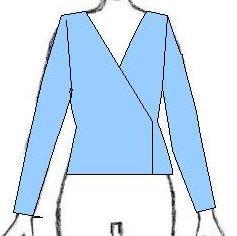
And if you really have to, you can do 3/4 sleeves or short sleeves or even no sleeves. Ha!
Well, why not? Two birds with one stone, sort of. Start with a KP&S pattern, and add BW’s genius. It has to be a success, right?
So: we are going to make a top-down sweater, with set-in style sleeves, and a V neck with a wrap front.
Yarn
I’ve got some pale sage-y blue-green Cleckheaton “Country 8-ply Naturals” — 13 balls I think, at 110 yards each, 1430 yards total. Suggested gauge = 22 sts to 4 inches. The ball band has a helpful little graphic that says for an average size 12 woman’s jumper, you’ll need about 14 balls.
So, we’re probably OK as far as yarn quantity goes.
.jpg) In our favor: fitted style with little ease, short armholes, short arms, V neck. Also the top-down thing discussed earlier.
In our favor: fitted style with little ease, short armholes, short arms, V neck. Also the top-down thing discussed earlier.
Not in our favor: the overlap of the wrap part.
Contingency plan: if I have to, I can add some lacy cuffs, a lace edging on the bottom, and a ruffle around the neckline in, say, a nice laceweight MOHAIR, to make it all look like it was planned. In fact, this might be really cute…!
Gauge
Since this is an older yarn (bought in 1999 at Webs one Xmas), I am more in agreement with the ball band info than I usually am with more modern yarns.
The suggested gauges for many current yarns are a bit on the loose side for a garment fabric, at least for my taste. Sure, I can knit a swatch and get the manufacturer’s recommended gauge — but the resultant fabric just seems a little too loosey-goosey to me for a sweater.
When I talk like this to students, they often tell me that they’ve never thought of “knitting a sweater” in terms of the fact that you are making a fabric. But, it’s really all about the fabric. A too-loose knitted fabric will not hold its shape, will show stitch inconsistencies more readily, will be easier to snag. It simply won’t hold up over time. Conversely, a fimer fabric makes a better quality garment. At a looser gauge, I suppose your yarn will go a bit farther, and you’ll get it done a bit quicker, but at what price? Kind of a pay-now-or-pay-later thing.
Anyway, the ball band suggests 22 sts to 4 inches on a US size 6, and lo and behold, that’s what I got! This is actually unusual for me, because I tend to knit on the loose side, and I usually have to go down at least one needle size from what is suggested — and often two sizes — to get the recommended gauge. (note: this is what the literary-type folk call “foreshadowing”.)
And, I am happy with the “hand” of the resultant fabric — nicely firm, not too open. One way to test this is to hold the fabric up and look through it: if you can see too much light coming through, it’s too loose. (I know that “too much” is a vague description — If I can figure out a way to take a picture of this someday, I will.)
Math
So in the normal course of events, it would be on to the m*th here. And I did do the math and whatnot, and started the back of the sweater, and knitted up about a ball’s worth of yarn. Then I decided it would be a good time for a blog picture, no?
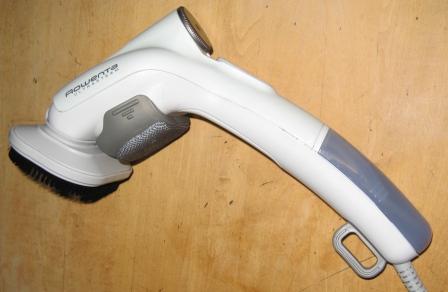 So, I got out my brand new toy — a Rowenta “steam brush” — which I thought would be very handy for steaming gauge swatches and such — and steamed the piece into submission.
So, I got out my brand new toy — a Rowenta “steam brush” — which I thought would be very handy for steaming gauge swatches and such — and steamed the piece into submission.
Did anyone notice the big disconnect there? Notice I said I made my swatch, then I did the math, started the sweater, THEN I got my new toy, and I steamed my garment-in-progress.
Guess what, kids? There is a reason you always hear teachers like me say,
“always block / wash / pre-treat your swatch the way you are going to wash your garment, because these processes can affect the gauge.”
Do as I say, not as I do.
In this case, I had NOT steamed the original swatch. And it appears that once I steamed the garment, the gauge did indeed change. It relaxed, from 5.5 sts per inch, to about 5.0 sts per inch. Notice this is a 10% difference…
The original idea was for the back of the sweater to be about 13″ wide. In actuality, it is close to 14.5″ wide: again, about a 10% difference.
(I should have been suspicious, I suppose, when I got the recommended gauge with the recommended needle size. Loose knitters don’t change their spots, so to speak.)
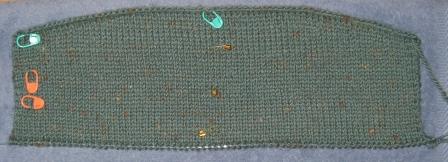
This extra inch-and-whatever may seem like a trivial thing to worry about, but the upper back width is really pretty crucial for proper fit. A too-wide upper back width is a common fit problem: Barbara W. even says explicitly “Don’t measure too much of it,” it being your upper back.
The whole garment is going to hang from the shoulders, including the sleeves — and those sleeves have weight to them, and that weight will cause the shoulders of the garment to stretch sideways when it is worn. (This is also a good reason to have shoulder seams, to offer resistance to that stretch, and I’ll get back to that concept in a later post.) If the shoulder width is a bit too big already, the shoulder seam line is just going to get pulled right off the shoulder bone and hang sadly on the upper arm. Ugh.
After I steamed the piece flat and measured it, and finished swearing, I did block it properly — which is to say, I sprayed it with plenty of water and let it dry naturally overnight. Sigh. Yes, the gauge has definitely changed — whether it is 100% due to my failure to block the swatch, or partially due to the changes that the Gauge Gods throw at you for fun when you go from a little gauge swatch to the real thing, I don’t know. I can always steam my original swatch and see if it changes, too. And, we can console ourselves with the comforting thought that we now have a much larger, and much more accurate, gauge swatch.
Well, it’s part of the price you pay for insisting on knitting with animal hair, instead of, say, steadfast, constant and unchanging plastic fibers.
I’ve been trying to talk myself out of redoing it for a couple of days, and I keep measuring across my shoulder bones and telling myself it’s not THAT bad.
I also dug out the schematic for the ol’ Nutcracker and checked the shoulder width on that baby, and guess what? It’s about 13″. I’ll be measuring the real sweater shortly to see what I actually knitted, but yeah, I think this is just going to be too damned big.
I’m finding that knitting out “in public”, as it were, is really very good for my flagging self-discipline, and y’all will probably make me do the right thing. But I can’t face it just yet. I’ll redo the math next time…
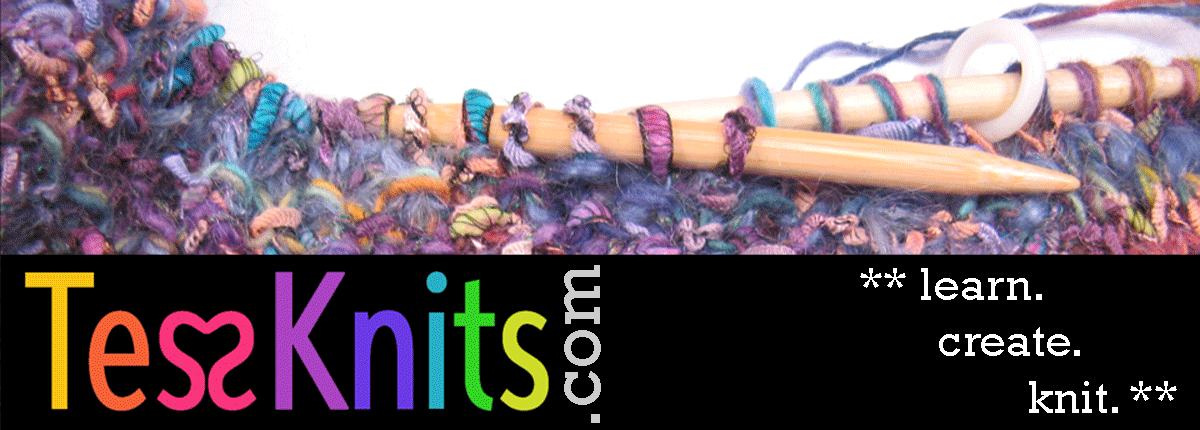
2 comments for “Wrap Cardigan, Part 1 – design, yarn, gauge, math”